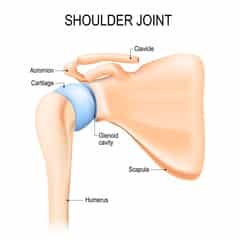Pop, click, ouch! If moving your shoulder triggers pain, weakness, popping or clicking, you may have a tear or fraying in the cartilage that helps keep your shoulder in place.
Let’s talk medical

That ring of cartilage is called the glenoid labrum, and it forms a rim around the site where your humerus (upper arm bone) fits into your shoulder socket. The cartilage is necessary for keeping your shoulder joint in place, since the head of the humerus is larger than the shoulder socket, somewhat like a golf ball on a tee.
What can go wrong with the shoulder
This design gives your upper arm its wide range of motion. That’s the good news. But it also makes the joint somewhat unstable and prone to injury.
Labral tears can be non-traumatic, caused by repetitive motion or strain. They also can be traumatic, caused by a fall, a car accident or other trauma.
Physical therapy for shoulder tears
Some labral tears are major and require surgery. The surgery should be followed up with a post-operative physical therapy program for optimal healing and restoration of joint function.
Mild to moderate tears that do not cause shoulder instability and do not require surgery often can be successfully managed with a comprehensive physical therapy program. Any physical therapy regimen should start with education about the cause of the injury and the reasons for suggested treatment.
Whether it’s to help rehabilitate the shoulder after surgery and avoid re-injury or it’s for an injury that does not require surgery, a PT regimen for a shoulder problem typically includes:
- Strengthening exercises that target the shoulder muscles, particularly the four muscles that comprise the rotator cuff surrounding the joint. These exercises can reduce the stress on the labrum and help stabilize the shoulder joint.
- Stretching exercises of the chest, shoulder and middle back muscles to further reduce the stress on the shoulder, especially for patients who enjoy sports that involve twisting motions, like golf or tennis.
- Posture exercises to discourage hunching or sagging the shoulders, which puts them at risk for injury. Proper posture can prevent further damage, promote healing of the injured shoulder and restore the balance of the surrounding muscles to help them work together effectively.
Exercises performed with the physical therapist should be continued at home for maximum effect. The physical therapist will give thorough instruction on how to follow up at home and at work. Your PT also may provide illustrations of proper lifting and exercising techniques, with explanations of how to avoid potentially harmful positions that place unnecessary stress on the shoulder joints.
Citations
Effects of Stretching and Strengthening Exercises, With and Without Manual Therapy, on Scapular Kinematics, Function, and Pain in Individuals with Shoulder Impingement: A Randomized Controlled Trial: J Orthop Sports Phys Ther 2015; 45(12):984–997. Epub 15 Oct 2015. doi: 10.2519/jospt.2015.5939.
Nonoperative treatment of superior labrum anterior posterior tears: improvements in pain, function, and quality of life: Am J Sports Med. 2010 Jul;38(7):1456-61. doi: 10.1177/0363546510370937. Epub 2010 Jun 3.
Current Concepts in the Evaluation and Management of Type II Superior Labral Lesions of the Shoulder: Open Orthop J. 2018; 12: 331–341. Published online 2018 Jul 31. doi: 10.2174/1874325001812010331
VeryWell Health.com (Health On the Net Certified Article): https://www.verywellhealth.com/physical-therapy-after-a-shoulder-labrum-tear-2696539
Move Forward PT.com (American Physical Therapy Association): https://www.moveforwardpt.com/symptomsconditionsdetail.aspx?cid=99c2e561-5a77-450c- 867a-2e2edaaa9b7c

